Woody the dog switches detection skills to save puffins
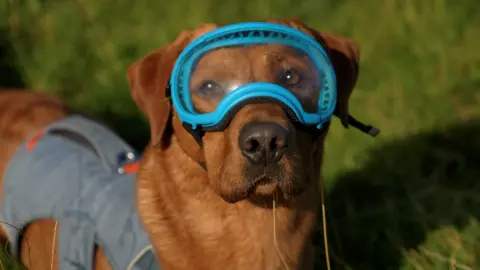 BBC
BBCHe was part of a world-first plan to rid an island off the coast of Northern Ireland of ferrets. Now, Woody the detection dog has his nose trained on Rathlin’s rats.
Ferrets and rats pose a grave risk to puffins and other seabirds who breed on Rathlin Island every year in their thousands.
The animals have been eating young birds and eggs.
Those behind the LIFE Raft project hope that eradication of both invasive species will help protect the seabird populations Rathlin is famous for.
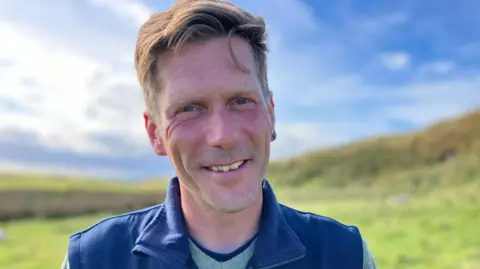
We first met Woody, the two-year-old Fox Red Labrador who is an important part of the project, back in May.
He does not track the animals themselves, but is trained to detect their droppings.
It is hoped that in time, he will be able to prove they have gone from the island.
“Woody is a big goof,” says his handler, Ulf Keller.
“He works for us as a detection dog. When he works he’s really focused and works really well but when he’s off work he’s a two-year-old Labrador, full of beans, jumping around.”
While it is Woody’s nose that is so invaluable to this project – his eyes are well looked after too.
He wears goggles to protect them from brambles and thistles.
“He’s treated like any other member of staff with his PPE and breaks after detecting scat,” Ulf said.
“He enjoys working, I enjoy working with him. I enjoy the island. I couldn’t have it any better, if I’m honest, and I think he likes it, too.”
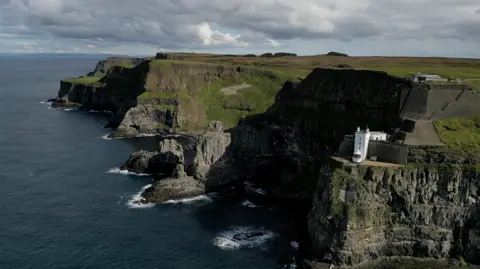
'27 dead puffins'
Following the capture and destruction of 98 ferrets, there has not been a confirmed sighting on Rathlin for months.
But the island will not be able to declare itself ferret free until next year.
The animals were introduced by a farmer in the 1980s to help control the rabbit population – but they soon started breeding and turned their attention to the seabirds.
Liam McFaul is the Royal Society for the Protection of Birds (RSPB) warden on Rathlin Island.
He has seen first hand just how much damage ferrets can do.
“It’s a bit like a fox in a chicken house, they just want to kill, kill, kill,” he said.
“Somehow a ferret - one ferret - managed to get down on a bank and we came down on a small boat to set some traps to catch it and when we went back in to recover the traps the next day, I picked up the carcasses of 27 dead puffins.
“So that’s just one animal, can you imagine what a hundred of them running round the cliffs can do?
“The overall trend is that the bird population is dropping and we would certainly look forward to seeing a recovery as soon as the predators are taken out.”
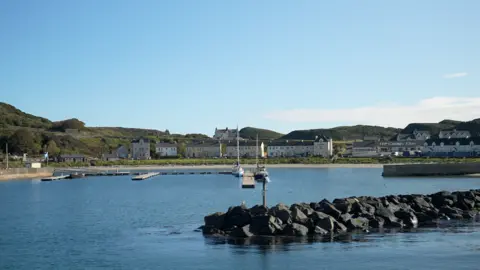
Rat trap
With an estimated 10,000 rats on Rathlin, the work required to begin eradicating them has been colossal.
About 7,000 bait stations have been laid, every 50 metres, including along the island’s many steep cliff faces.
The bait has now been placed inside the traps.
It is believed the rats will take it back to their burrows, where they will ingest it and die.
Michael Rafferty is the Operations Manager for the LIFE Raft project.
“This is ten-fold to what we had with the ferrets.
“The ferret eradication is a global first, rat eradications have happened – there have been almost 500 recorded cases of rat eradications,” he said.
“So it’s definitely achievable. That doesn’t say it’s not an almighty task. It’s a major handling that we’re taking on.”
Kevin Rutherford is assisting the rat trap team to tackle the cliffs.
“The weather has been a challenge and we had a cow that was nibbling our ropes which wasn’t ideal,” he said.
“It’s a pretty huge undertaking and these bait stations will be checked every week.
“We have decades of climbing experience between us but this is a big project. It’s keeping us thinking and coming up with solutions.”
'Rathlin is a special place'
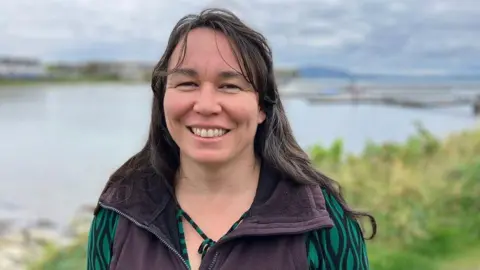
Rathlin is home to about 150 residents.
Marianne Green is one of the islanders looking forward to a rat and ferret-free home.
“Once work began to get rid of the ferrets, people have been able to keep chickens again which has been really nice,” she said.
“And no-one wants rats. You can see some pretty large ones down by the harbour.”
But what about those who may argue the eradication process is cruel?
“Yeah but we are an island so we are kind of like a refuge point for those ground nesting birds,” Ms Green said.
“Rathlin is a special place, and people still have that belonging to the land. And because we live on an island, we see how things are affected really quickly.
“We know that by getting rid of the ferrets and the rats we will help the local ground nesting birds.
"They’re finding it so tough with climate change and bird flu and everything else that’s happening out there so by getting rid of one of the pressures, that means they’ll be able to build up their numbers here.
“By removing just one of the obstacles for them, we hope they’ll thrive again on Rathlin.”
The £4.5m LIFE Raft project is funded by EU LIFE, National Lottery Heritage Fund, Garfield Weston Foundation and Stormont's Department of Agriculture, Environment and Rural Affairs (Daera).
